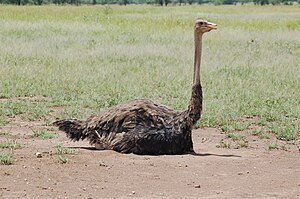Portal:Tanzania
 The Tanzania Portal
Tanzania, officially the United Republic of Tanzania, is a country in East Africa within the African Great Lakes region. It is bordered by Uganda to the northwest; Kenya to the northeast; the Indian Ocean to the east; Mozambique and Malawi to the south; Zambia to the southwest; and Rwanda, Burundi, and the Democratic Republic of the Congo to the west. Mount Kilimanjaro, Africa's highest mountain, is in northeastern Tanzania. According to the 2022 national census, Tanzania has a population of nearly 62 million, making it the most populous country located entirely south of the equator. Many important hominid fossils have been found in Tanzania, such as 6-million-year-old Pliocene hominid fossils. In the Stone and Bronze Age, prehistoric migrations into Tanzania included Southern Cushitic speakers who moved south from present-day Ethiopia; Eastern Cushitic people who moved into Tanzania from north of Lake Turkana about 2,000 and 4,000 years ago; and the Southern Nilotes, including the Datoog, who originated from the present-day South Sudan–Ethiopia border region between 2,900 and 2,400 years ago. These movements took place at about the same time as the settlement of the Mashariki Bantu from West Africa in the Lake Victoria and Lake Tanganyika areas. In the late 19th century, the mainland came under German rule as German East Africa, and this was followed by British rule after World War I when it was governed as Tanganyika, with the Zanzibar Archipelago remaining a separate colonial jurisdiction. Following their respective independence in 1961 and 1963, the two entities merged in 1964 to form the United Republic of Tanzania. Tanganyika joined the British Commonwealth and Tanzania remains a member of the Commonwealth as a unified republic. Tanzania is mountainous and densely forested in the north-east, where Mount Kilimanjaro, the highest mountain in Africa and the highest single free-standing mountain above sea level in the world, is located. Three of Africa's Great Lakes are partly within Tanzania. To the north and west lie Lake Victoria, Africa's largest lake, and Lake Tanganyika, the continent's deepest lake, known for its unique species of fish. To the south lies Lake Malawi. The eastern shore is hot and humid, with the Zanzibar Archipelago just offshore. The Menai Bay Conservation Area is Zanzibar's largest marine protected area. The Kalambo Falls, located on the Kalambo River at the Zambian border, is the second-highest uninterrupted waterfall in Africa. Tanzania is one of the most visited tourist destinations for safaris. Selected article -
Bongo Flava is a nickname for Tanzanian music. The genre developed in the 1990s, mainly as a derivative of American hip hop and traditional Tanzanian styles such as taarab and dansi, with additional influences from reggae, R&B, and afrobeats, to form a unique style of music. Lyrics are usually in Swahili or English, although increasingly from mid 2000s there has been limited use of words from Sub-Saharan African music traditions due to the influence of Afrobeats and Kwaito with their dynamics usage of West African Pidgin English, Nigerian Pidgin or other Creole language. (Full article...)
General images -The following are images from various Tanzania-related articles on Wikipedia.
This month in Tanzanian history
Wildlife of Tanzania - Credit: Joachim Huber
The Ostrich, Struthio camelus, is a large flightless bird native to Africa. It is the only living species of its family and its genus. Ostriches share the order Struthioniformes with the kiwis, Emus, and other ratites. It is distinctive in its appearance, with a long neck and legs and the ability to run at maximum speeds of about 70 km/h (45 mph), the top land speed of any bird. Did you know ...
CategoriesWikiProjectsRecognised contentSelected panorama -Moshi is a Tanzanian town with a population of 144,739 (2002 census) in Kilimanjaro Region. The town is situated on the lower slopes of Mt Kilimanjaro, a volcanic mountain that is the highest mountain in Africa. Moshi is home to the Chagga and Maasai tribes and lies on the A 23 Arusha-Himo east-west road connecting Arusha and Mombasa, Kenya. Just to the east of Moshi is the intersection with the B 1 north-south road eventually connecting with Tanga and Dar es Salaam.
Uganda–Tanzania War -Articles here focus upon aspects of the Uganda–Tanzania War. These are all Good articles that meet a core set of high editorial standards.
The Uganda–Tanzania War of 1978–79 included an air campaign, as the air forces of Uganda and Tanzania battled for air superiority and launched bombing raids. In general, the conflict was focused on air-to-ground attacks and ground-based anti-aircraft fire; only one dogfight is known to have occurred. The Uganda Army Air Force dominated the air space during the initial Ugandan invasion of northwestern Tanzania, but achieved little due to bad co-ordination with ground forces and a general lack of planning. At the same time, it suffered increasingly heavy losses as pilots deserted, and the Tanzanian anti-aircraft defenses became more effective. The initiative thus switched to the Tanzania Air Defence Command which supported the country's counter-offensive into Uganda. In the conflict's later stages, the Libyan Arab Republic Air Force intervened on the side of Uganda, but failed to make a tangible impact. The Uganda Army Air Force was eventually destroyed on 7 April 1979 when Tanzanian ground forces overran its main air base at Entebbe. The remaining Ugandan loyalist air pilots subsequently fled the country or joined the Libyan military. (Full article...)TopicsSelected picture -Related portalsThings you can doAssociated WikimediaThe following Wikimedia Foundation sister projects provide more on this subject:
Discover Wikipedia using portals | ||||









































































